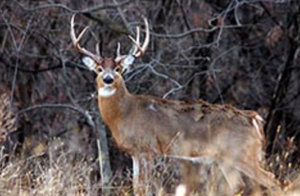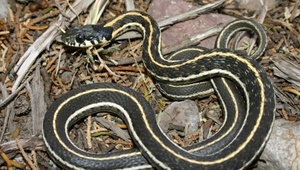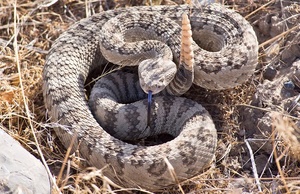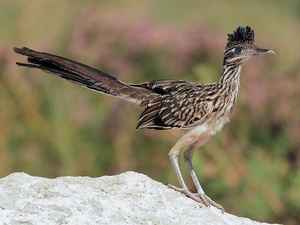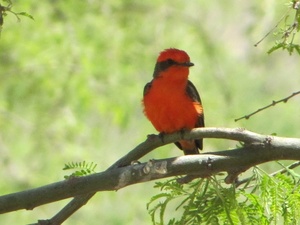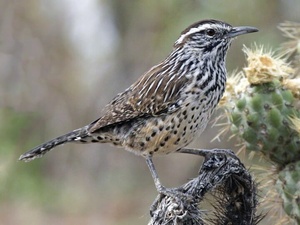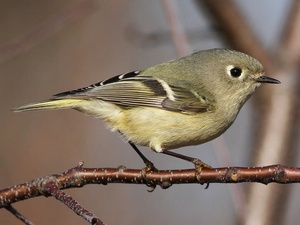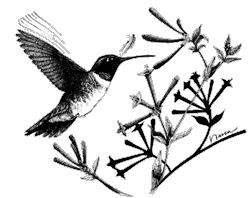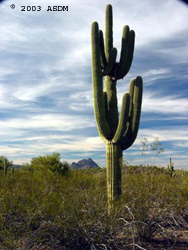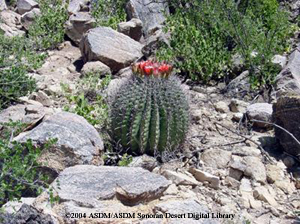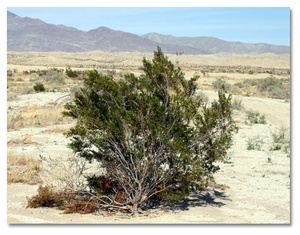What is Seven Falls?
Seven Falls is located in the Sabino Canyon of Tucson, Arizona. Seven Falls is a well known hiking trail in Tucson because of its beautiful scenery and well known waterfall. The Sabino Canyon was created by an earthquake that occurred in northern Mexico in the late 1880’s. Along the Seven Falls hike you can see boulders lining the canyon wall that remain from the earthquake which is pretty interesting! The area was taken over in 1905 where the hike then became accessible by foot, bike, or tram. Seven Falls is in fact just one waterfall, however along the hike there are seven stream crossings along the way. People are welcome to rest or swim in the chilling water. It is said the best times of year to hike Seven Falls is either at the very end of winter or the very beginning of spring. The reason for this is due to storms and snow melting from the mountains that creates the waterfall to flow more. It is said that many people enjoy the rare beauty of the waterfall due to it being in the middle of the desert canyon's. Seven Falls was been "#1 rated trail in Tucson by All Trails, it boasts seven waterfalls, incredible views, and a moderately easy hike"(Arizona Hikers Guide).
Location of Seven Falls: 5700 N Sabino Canyon Rd, Tucson, AZ 85750
 People enjoying Seven Falls. Photo was from https://www.tucsontopia.com/sabino-canyon/
People enjoying Seven Falls. Photo was from https://www.tucsontopia.com/sabino-canyon/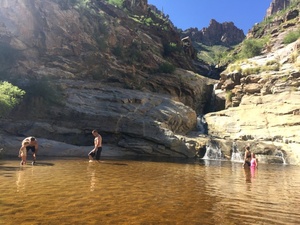 People enjoying Seven Falls. Photo was from http://www.taushpointo.com/2016/09/explore-arizona-tucson-seven-falls-2.html
People enjoying Seven Falls. Photo was from http://www.taushpointo.com/2016/09/explore-arizona-tucson-seven-falls-2.html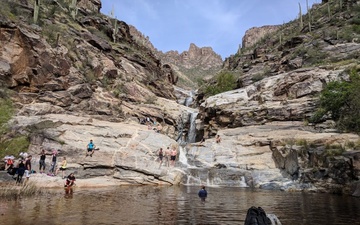 People enjoying Seven Falls. Photo was fromhttps://www.tucsonrentalhomes.com/seven-falls
People enjoying Seven Falls. Photo was fromhttps://www.tucsonrentalhomes.com/seven-falls
What to Expect the Hike to be Like
The Seven Falls trail is "rated a medium" because it is just over eight miles long and there are creek crossings that occur throughout the trail. There is a tram available to the public that cuts the hike in half. Tram cuts of "1.8 miles each way and will make the hike only 4.6 miles roundtrip" (No Man Before). It is said that the trail takes about four hours to hike unless you have a child which could range from five to six hours to hike.
Trailhead Elevation for Seven Falls: 2,732 feet
Distance Round Trip: 8.2 miles
Monsoon Season
Due to Seven Falls being located in Tucson, Arizona there are many monsoons that occur. It can be very dangerous to hike Seven Falls after a monsoon due to flash floods occurring throughout the mountain in which Seven Falls is located. The creek crossings could almost be impossible to cross or could sweep you away due to flooding. It is highly suggested to wear water shoes a few days after a monsoon occurs due to over flowing water in the creek crossings and at the falls.
What to Pack to Hike Seven Falls
Due to Seven Falls being a medium rated trail there are important items that you should be prepared to have while hiking. Make sure to bring plenty of water for this hike. Even though you are hiking to a waterfall the hike if a rough terrain through the Arizona desert. Due to there being creek crossings throughout the trail and a waterfall at the end of the trail either pack or wear shoes that you are prepared to get wet. If you are planning on jumping into the creek in which the waterfall has created pack swimwear or extra clothes that are dry.
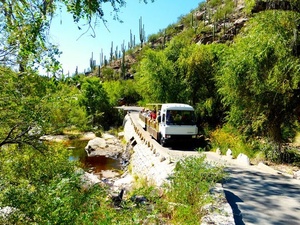 One of the trams taking people through the beginning of the trail. Photo was from https://www.azcentral.com/story/travel/arizona/hiking/2016/11/03/sabino-canyon-tucson-hike-tram-picnic/92906352/
One of the trams taking people through the beginning of the trail. Photo was from https://www.azcentral.com/story/travel/arizona/hiking/2016/11/03/sabino-canyon-tucson-hike-tram-picnic/92906352/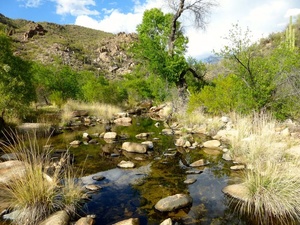 Creek crossing. Photo was from https://www.azcentral.com/story/travel/arizona/hiking/2016/11/03/sabino-canyon-tucson-hike-tram-picnic/92906352/
Creek crossing. Photo was from https://www.azcentral.com/story/travel/arizona/hiking/2016/11/03/sabino-canyon-tucson-hike-tram-picnic/92906352/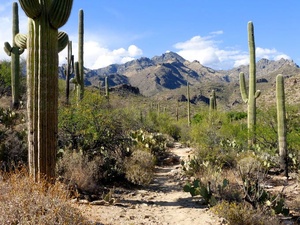 What the trail is like going to Seven Falls. Photo was from https://www.azcentral.com/story/travel/arizona/hiking/2016/11/03/sabino-canyon-tucson-hike-tram-picnic/92906352/
What the trail is like going to Seven Falls. Photo was from https://www.azcentral.com/story/travel/arizona/hiking/2016/11/03/sabino-canyon-tucson-hike-tram-picnic/92906352/
Pricing for Seven Falls
Entrance Fee for Adults (13+) : $15.50
Entrance Fee for Seniors and Military (with ID) : $12.75
Entrance Fee for Children (Ages 2 – 12 years) : $9.50
Entrance Fee for Children under 2 years old: Free
Tram Ride for Adults (13+): Additional $10 (tram ride is optional)
Tram Ride for Children (3-12) : Additional $5 (tram ride is optional)
Tram Ride for Children under 3 years old: Free (tram ride is optional)
Parking: $5 per vehicle
Hours of Operation for Seven Falls
Visitor center opens at 8am and closes at 4:30pm everyday. Visitor center is closed on both Thanksgiving and Christmas.
Is Seven Falls Pet Friendly?
Seven Falls is not a pet friendly hiking trail.
Trail Description
The beginning of the trail (1.8 miles) is quite easy. It is wide road that due the tram needed to get through it. Though if you decided not to take the tram, you will still see plenty of people walking on this road as well as the tram passing by. When getting to the trailhead, there are bathrooms that you are welcome use and they even have refill stations for your water bottles or camelbacks (highly suggested to refill as much as possible). After passing the trail head, there are inclines throughout the trail due to you going higher up in the canyon to see the waterfall. You will be walking through the desert so it is important that you are wearing closed toed shoes. There creek crossings are "clustered together in a 0.6 mile stretch". There are seven creek crossing when hiking this trail. After passing the last creek crossing you will begin to hike "the right side of Bear Creek" (Arizona Hikers Guide). The trail will a bit rocky after this, but it "eventually... flattens and you’ll reach a trail fork shortly after the seventh crossing" (Arizona Hikers Guide). After this, it is important you go towards the left if you are looking for the waterfall (there will be signs to help). You'll hike down towards the left and you will find the falls. Many people are sunbathing, taking photos, and even swimming/cliff jumping into the creek below the falls.
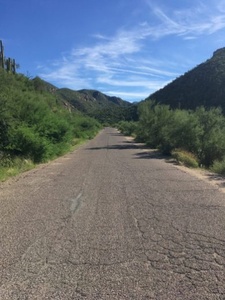 Photo of the first 1.8 miles of Seven Falls. Photo was from https://www.tucsontopia.com/sabino-canyon/
Photo of the first 1.8 miles of Seven Falls. Photo was from https://www.tucsontopia.com/sabino-canyon/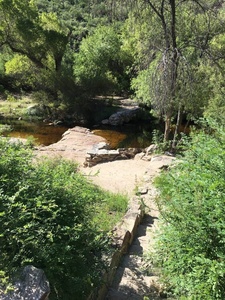 One of the creek crossing. Photo was from https://www.tucsontopia.com/sabino-canyon/
One of the creek crossing. Photo was from https://www.tucsontopia.com/sabino-canyon/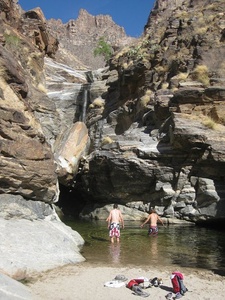 People enjoying the falls. Photo was from https://www.tucsonweekly.com/TheRange/archives/2013/05/13/surviving-tucson-a-guide-to-ones-first-summer-in-the-old-pueblo
People enjoying the falls. Photo was from https://www.tucsonweekly.com/TheRange/archives/2013/05/13/surviving-tucson-a-guide-to-ones-first-summer-in-the-old-pueblo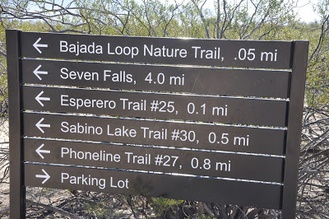 One of the trailhead signs for Seven Falls. Photo was from http://www.sunshinenomads.com/2016/02/tucson-arizona-sabino-recreation-area.html
One of the trailhead signs for Seven Falls. Photo was from http://www.sunshinenomads.com/2016/02/tucson-arizona-sabino-recreation-area.html
Plants and Animals Found in the Area
The beauty of the man-made waterfalls, streams, and mountains along the Seven Falls hike is unbeatable, but there is much more wildlife that many people forget about! Some of the species you may want to look out for include:
Collared Peccaries: More commonly known as “javelinas”, these mammals have a pig-like snout, large head, small legs with hoofed feet, and are brownish gray with a whiteish collar of fur around its neck. These animals are more active at night, or in cooler temperatures, and are extremely territorial. A peccary will warn off any intruder, human or other animal, by laying back its ears and chattering its teeth. You definitely want to stay clear of these animals if you run into them during the hike as they may charge headfirst at its intruder and bite or lock jaws with it, and small pig like animal that you can usually find in herds. 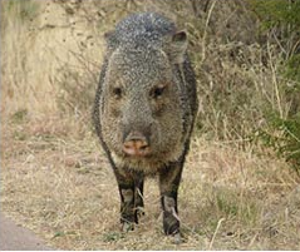
Photo was used from/nhpbs.org/natureworks/peccary.htm
White Tail Deer: A larger mammal, the white-tailed deer is tan or brown during the summer months and grayish brown during the winter months. It is easy to identify these animals by the white fur on its throat, around its eyes, stomach, and nose. The male deer has antlers, while females do not. These animals gather in groups of a mother and her fawns (baby deer). When a female has no fawns, she will stay solitary while male bucks live in groups of three or our four except during mating season (November) they remain solitary. If you run into a white-tailed deer along the hike, it will most likely be alarmed and run in the opposite direction.
Photos used from /nhpbs.org/natureworks/whitetaileddeer.htm
Snakes: In the Sabino Canyon, you can also find various types of snakes. Two commonly seen are the garter snakes and rattlesnakes. Garter snakes are found in the damper areas and are harmless, where rattlesnakes are dangerous and enjoy all areas in the desert. You definitely want to keep your eyes peeled as these animals blend in easily.
Photo on the left used from /www.gosanangelo.com/story/news/local/scene/2019/11/10/gartnersnakes-defenses-include-bad-smell/101632660/
Photo on the right used from/mendovoice.com/2019/04/its-rattlesnake-season-heres-some-tips-to-avoid-a-bite/
Birds: As you can imagine, there are many species of birds throughout the area. Some of the more common birds to look out for include:
Road Runners – These birds thrive in desert landscapes and can outrun humans and kill predators such as rattlesnakes. You can identify these birds by their long neck, legs, and tail, as well as a long heavy bill. They’re mostly brown with white streaks over most of their body with a lighter belly. Seeing one is usually a surprise as they tend to stay in quiet areas in arid grasslands and low deserts.
Photo used from /www.allaboutbirds.org/guide/Greater_Roadrunner/overview
Vermilion Flycatchers – Of all the different species of birds, the vermilion flycatcher will definitely get your attention. The male looks as if it has ruby wings, and is spotted by its red crown and belly, while the female is more of a pale pink or salmon color. Usually common in the wintertime, these birds perch on low branches and venture out to grab insects and return to their perch. Definitely keep your eyes peeled for these beautiful creatures if you hike Seven falls during the winter months!
Photo used from /saddlebagnotes.com/the-vermilion-flycatcher-a-ruby-with-wings/article_b03f3588-0189-11e9-9a6c-eb49f48ddd11.html
Cactus Wrens – At all hours of the day, the cactus wren lets out a scratchy noise that makes them easily identifiable. They are small speckled brown birds, with bright white eyebrows, a long bill and tail, and short rounded wings. Found in a cholla or prickly-pear cacti in the desert, you know you found the cactus wren when you see football shaped clumps of vegetation stuck in the cactus. They are very common, so definitely listen and look out for this native bird on your hike.
Photo used from /www.allaboutbirds.org/guide/Cactus_Wren/media-browser/68034441
Ruby Crowned Kinglets – These tiny songbirds can be identified by their small tail and bill, unique olive-green color, and white ring around its eyes. A key factor in identifying these birds is by the flickering of its wings. Males may flash a red crown when excited, but otherwise remains hidden and you cannot rely on seeing the crown. These birds are filled with energy and hop around lower branches of shrubs and trees. They are easy to overlook, but yet again if you find yourself hiking Seven Falls during the winter months keep your eyes peeled for these little guys.
Photo used from /www.allaboutbirds.org/guide/Ruby-crowned_Kinglet/overview
Hummingbirds – There are several species of hummingbirds to be found in this area, and they are the smallest birds in the world. They have very long beaks and their fast wings allow them to hover over plants and feed. They have many different colors and patterns, the easiest way to identify them is by their beaks and wings. They are extremely quick, so it is quite rare to see them along the hike!
Photo used from /www.desertmuseum.org/books/nhsd_hummingbirds.php
Saguaro Cactus – One of the most commonly known and defining plants of Tucson, the saguaro cactus is a large plant that develops arm like branches and are covered with protective spines. These spines flower in the spring and red fruit in the summer months. You will see these all over the hike, and they are very easy to spot!
Photo used from /www.desertmuseum.org/kids/oz/long-fact-sheets/Saguaro Cactus.php
Fishhook barrel cactus – This barreled shape cactus has long hooked spines that when in full bloom, yellow or red fruit grows at the top of the plant. The cactus does not usually grow above 10 feet, and you are more likely to see them along the desert washes.
Photo used from /www.desertmuseum.org/kids/oz/long-fact-sheets/Fishook Barrel Cactus.php
Creosote bush – This shrub has flexible stems that can grow up to 12 feet high, but usually remains around 4 feet. It has small waxy yellow-green leaves that requires a large amount of water to survive. These plants are extremely common, and you are guaranteed to get a glimpse along the trail.
Photo used from /www.desertusa.com/creoste.html
More information
Phone number for the visitor center: 520-749-2861
Website for visitor center/Seven Falls: www.sabinocanyon.com.
Phone number for guided hikes: 520-429-4492
Website for guided hikes: www.sabinonaturalists.org.
References
http://nomanbefore.com/hiking-seven-falls-trail-tucson-arizona/
http://www.arizonahikersguide.com/all-hikes/hike-seven-falls-tucson
https://www.fs.usda.gov/coronado/

